
 As the relentless drive of the Nazi juggernaut ground in on the surrounded units, many men and small groups made desperate attempts to cut their way out. A number were killed or captured, but a few made it. Two who succeeded were 1/Sgt Wallace G. Rifleman (Green Bay, Wis) and Capt Edward H. Murray (Cabin Creek, WVa) both of George Co 423-IR. With several others, the pair started for the American lines under cover of the night. There was a bridge over the Our River guarded by three Germans guards they bypassed in an enemy motor pool and radar station. Another couple of German guards on a building were silenced in hand to hand combat. Two Germans who rose from foxholes to try to bar their way were also liquidated. Encounters with an enemy tank, a German artillery crew, and a close escape from a heavily armed combat patrol sent out to track them down rounded out the adventure. Sgt Rifleman won the Silver Star for gallantry in action in a subsequent battle.
As the relentless drive of the Nazi juggernaut ground in on the surrounded units, many men and small groups made desperate attempts to cut their way out. A number were killed or captured, but a few made it. Two who succeeded were 1/Sgt Wallace G. Rifleman (Green Bay, Wis) and Capt Edward H. Murray (Cabin Creek, WVa) both of George Co 423-IR. With several others, the pair started for the American lines under cover of the night. There was a bridge over the Our River guarded by three Germans guards they bypassed in an enemy motor pool and radar station. Another couple of German guards on a building were silenced in hand to hand combat. Two Germans who rose from foxholes to try to bar their way were also liquidated. Encounters with an enemy tank, a German artillery crew, and a close escape from a heavily armed combat patrol sent out to track them down rounded out the adventure. Sgt Rifleman won the Silver Star for gallantry in action in a subsequent battle.
 Enemy artillery fire on the second day of the attack damaged a mortar base manned by Pfc Harry V. Arvannis (Moline, Ill) 424-IR. He resumed fire, holding the tube between his legs and aiming by hand. After firing about 50 rounds, he saw a squad of Nazi infantrymen creeping toward his position. Training the mortar on them, he shot his last 30 rounds of ammunition, killing or disabling eight of his attackers. The other four rose to their feet and lunged at him in a bayonet charge. Arvannis and his assistant gunner emptied their service pistols, stopping three of the four. The fourth was upon them, bayonet gleaming. Pfc Arvannis threw his four pound revolver at the German, hitting him squarely in the forehead and knocking him down instantly.
Enemy artillery fire on the second day of the attack damaged a mortar base manned by Pfc Harry V. Arvannis (Moline, Ill) 424-IR. He resumed fire, holding the tube between his legs and aiming by hand. After firing about 50 rounds, he saw a squad of Nazi infantrymen creeping toward his position. Training the mortar on them, he shot his last 30 rounds of ammunition, killing or disabling eight of his attackers. The other four rose to their feet and lunged at him in a bayonet charge. Arvannis and his assistant gunner emptied their service pistols, stopping three of the four. The fourth was upon them, bayonet gleaming. Pfc Arvannis threw his four pound revolver at the German, hitting him squarely in the forehead and knocking him down instantly.
Heroes Upset von Runbstedt Timetable
 There are stories, too, of units that fought and served in the face of overwhelming odds: the 106-QM Co, the 106-MP Plat, the 106-Signal Co, the Division Band and the 106-MED Bn. Each received the Meritorious Service Unit Plaque. Despite intense enemy artillery and small arms fire, the MP Platoon kept traffic flowing and performed other duties all during the German counter-offensive. At St Vith, when shelling by the enemy was at its heaviest, the men at the traffic posts were forced to take a prone position, but they stuck to their posts and directed traffic. During this critical period, over 700 POWs were handled by the platoon.
There are stories, too, of units that fought and served in the face of overwhelming odds: the 106-QM Co, the 106-MP Plat, the 106-Signal Co, the Division Band and the 106-MED Bn. Each received the Meritorious Service Unit Plaque. Despite intense enemy artillery and small arms fire, the MP Platoon kept traffic flowing and performed other duties all during the German counter-offensive. At St Vith, when shelling by the enemy was at its heaviest, the men at the traffic posts were forced to take a prone position, but they stuck to their posts and directed traffic. During this critical period, over 700 POWs were handled by the platoon.

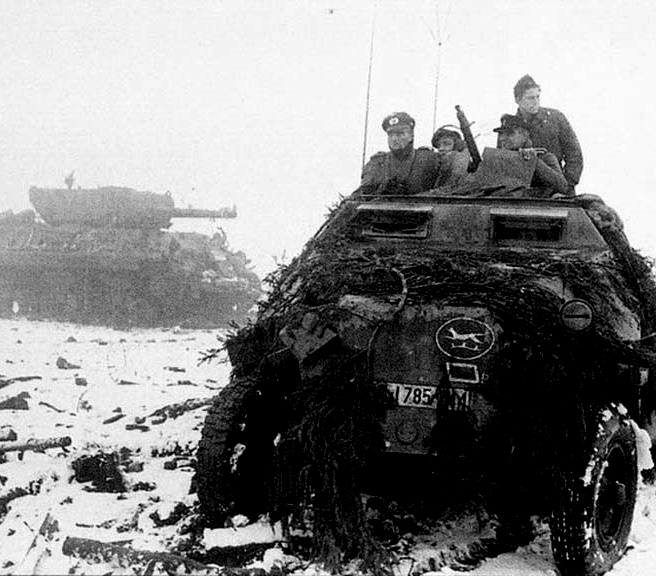 When St Vith finally fell to the enemy, all remaining PWs were marched to Vielsalm under cover of darkness. This operation was accomplished without the loss of a single prisoner. Members of the platoon conducted ammunition trains over routes which were under constant artillery fire. They helped stragglers to get back to their own units and into the fight. They reconnoitered roads, planned roadblocks, crippled an enemy tank, destroyed an enemy staff car with its officer occupants.
When St Vith finally fell to the enemy, all remaining PWs were marched to Vielsalm under cover of darkness. This operation was accomplished without the loss of a single prisoner. Members of the platoon conducted ammunition trains over routes which were under constant artillery fire. They helped stragglers to get back to their own units and into the fight. They reconnoitered roads, planned roadblocks, crippled an enemy tank, destroyed an enemy staff car with its officer occupants.
 The 106-QM Co, composed almost entirely of New England personnel, found itself partially surrounded at times, and had to depend on the ingenuity of its men to get the supplies through. On December 19, the ration shortage was becoming critical in Vielsalm due to the enemy advance and destruction of supply depots. Twelve QM trucks set out to find a depot still open. Rations and Gasoline were located at Dinant, Belgium. For security, the trucks made the 35-mile return trip in two serials. The first arrived in Vielsalm on tne December 20. The second ran into a furious tank battle near St Hubert, detoured, avoided destruction and got through to Vielsalm with all supplies intact.
The 106-QM Co, composed almost entirely of New England personnel, found itself partially surrounded at times, and had to depend on the ingenuity of its men to get the supplies through. On December 19, the ration shortage was becoming critical in Vielsalm due to the enemy advance and destruction of supply depots. Twelve QM trucks set out to find a depot still open. Rations and Gasoline were located at Dinant, Belgium. For security, the trucks made the 35-mile return trip in two serials. The first arrived in Vielsalm on tne December 20. The second ran into a furious tank battle near St Hubert, detoured, avoided destruction and got through to Vielsalm with all supplies intact.
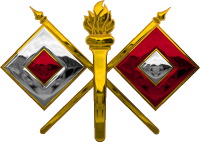 As the fury of the battle mounted, maintenance of communications became literally a matter of life or death. Skill and courage of signalmen of the 106-Signal Co, and in the regiments kept the vital communication lines open whenever it was humanly possible. Again and again through the whole division sector, trouble shooters made emergency repairs on lines severed by artillery fire. For signalmen, field splices under enemy small arms fire became almost commonplace.
As the fury of the battle mounted, maintenance of communications became literally a matter of life or death. Skill and courage of signalmen of the 106-Signal Co, and in the regiments kept the vital communication lines open whenever it was humanly possible. Again and again through the whole division sector, trouble shooters made emergency repairs on lines severed by artillery fire. For signalmen, field splices under enemy small arms fire became almost commonplace.
 New lines frequently were laid through territory teeming with enemy patrols. While the town of Schönberg was under heavy bombardment by the Germans, four men of the Signal unit stayed at their switchboard while the building in which they were located was blown down around them. A shell ripped off the rear of the structure. Another reduced the right side to rubble, and the roof collapsed as a third shell tore into the structure. Still the men stayed at their post. A fourth shell landed behind the switchboard, wounding two of the operators. They destroyed the board and withdrew only when ordered to leave by a superior officer, after German infantry had entered the town in strength as the barrage lifted. These men were T/5 Seymour H. Zorn (New York City); T/5 James R. Leonard and Pfc Donald A. Allen, both of (Pittsburgh, Pa) and Pvt Archie L. King (Muscatine, Ia).
New lines frequently were laid through territory teeming with enemy patrols. While the town of Schönberg was under heavy bombardment by the Germans, four men of the Signal unit stayed at their switchboard while the building in which they were located was blown down around them. A shell ripped off the rear of the structure. Another reduced the right side to rubble, and the roof collapsed as a third shell tore into the structure. Still the men stayed at their post. A fourth shell landed behind the switchboard, wounding two of the operators. They destroyed the board and withdrew only when ordered to leave by a superior officer, after German infantry had entered the town in strength as the barrage lifted. These men were T/5 Seymour H. Zorn (New York City); T/5 James R. Leonard and Pfc Donald A. Allen, both of (Pittsburgh, Pa) and Pvt Archie L. King (Muscatine, Ia).
 Medics of the 106-ID also distinguished themselves in the bloody Ardennes. One was T/5 Marshall W. Walker (Tryon, NC), who made repeated trips by jeep through German-held territory near Winterspelt to evacuate 424-ID wounded. Capt Philip J. Antrim (Wichita Falls, Kan), 424-IR’s Battalion Surgeon, found that deep snow, rough terrain, roving enemy patrols and the number of casualties prevented litter bearers from bringing wounded to his aid station fast enough. He packed equipment on his back, went forward to treat men where they had fallen. Capt Antrim received the Bronze Star and was decorated for two other heroic deeds in the next five weeks.
Medics of the 106-ID also distinguished themselves in the bloody Ardennes. One was T/5 Marshall W. Walker (Tryon, NC), who made repeated trips by jeep through German-held territory near Winterspelt to evacuate 424-ID wounded. Capt Philip J. Antrim (Wichita Falls, Kan), 424-IR’s Battalion Surgeon, found that deep snow, rough terrain, roving enemy patrols and the number of casualties prevented litter bearers from bringing wounded to his aid station fast enough. He packed equipment on his back, went forward to treat men where they had fallen. Capt Antrim received the Bronze Star and was decorated for two other heroic deeds in the next five weeks.
 Men of the 331-MRD Bn also followed the Service Above Self motto. Collecting Companies (Able, Baker and Charlie), supporting the 422, 423 and 424-IRs, respectively treated and evacuated the wounded so efficiently that Clearing Company (Dog) had only six deaths among all the wounded treated during the Ardennes Campaign. Dog Co, functioned for three days and nights as a field hospital in the Vielsalm area, although completely surrounded.
Men of the 331-MRD Bn also followed the Service Above Self motto. Collecting Companies (Able, Baker and Charlie), supporting the 422, 423 and 424-IRs, respectively treated and evacuated the wounded so efficiently that Clearing Company (Dog) had only six deaths among all the wounded treated during the Ardennes Campaign. Dog Co, functioned for three days and nights as a field hospital in the Vielsalm area, although completely surrounded.
 Two other units of the division won praise for a difficult job well done, the 806-OD Co which worked under trying conditions, and the 106-ID’s Band, which fought as infantry in the defense of St Vith.
Two other units of the division won praise for a difficult job well done, the 806-OD Co which worked under trying conditions, and the 106-ID’s Band, which fought as infantry in the defense of St Vith.  During the period of December 19-21, the 112-IR (28-ID), the right (South) flank of the 106-ID, was cut off from its own division. This Regimental Combat Team had been attached to the 106-ID, and with the 424-IR, held against German attacks south of St Vith.
During the period of December 19-21, the 112-IR (28-ID), the right (South) flank of the 106-ID, was cut off from its own division. This Regimental Combat Team had been attached to the 106-ID, and with the 424-IR, held against German attacks south of St Vith.
424-IR Lashes Back at Manhay

 The fall of St Vith became inevitable late December 21. All units of the 106-ID and the 7-AD withdrew to form a perimeter defense west of the town and east of the Salm River.
The fall of St Vith became inevitable late December 21. All units of the 106-ID and the 7-AD withdrew to form a perimeter defense west of the town and east of the Salm River.


 These positions were held against renewed attacks the next day. Orders were received on December 22 from Gen Matthew B. Ridgway’s XVIII Corps (Airborne) to withdraw farther fo the west. The 82-A/B was moving into positions along the Salm River and a line running west from Salmchâteau.
These positions were held against renewed attacks the next day. Orders were received on December 22 from Gen Matthew B. Ridgway’s XVIII Corps (Airborne) to withdraw farther fo the west. The 82-A/B was moving into positions along the Salm River and a line running west from Salmchâteau.

 Elements of the 106-ID, the 7-AD (CCB) and the 9-AD (CCB) were to move back to the northwest through new lines formed by the paratroopers. Careful planning and leadership enabled the units to pull back under constant enemy infantry and tank attacks. The successful withdrawal across the two remaining routes over the Salm River was completed by night of December 23. It was at the start of the withdrawal across the Salm that Gen. Alan W. lones became a casualty and was evacuated to a hospital in Liege. Gen Herbert T. Perrin (106-ID ADC), assumed command. That night and the next day, the weary battle-bruised survivors of the first week of the Ardennes breakthrough took their first respite from battle. Without blankets, with barely enough rations, and unable to light fires for warmth, they dug in on a windswept hill in the vicinity of Werbomont, Belgium.
Elements of the 106-ID, the 7-AD (CCB) and the 9-AD (CCB) were to move back to the northwest through new lines formed by the paratroopers. Careful planning and leadership enabled the units to pull back under constant enemy infantry and tank attacks. The successful withdrawal across the two remaining routes over the Salm River was completed by night of December 23. It was at the start of the withdrawal across the Salm that Gen. Alan W. lones became a casualty and was evacuated to a hospital in Liege. Gen Herbert T. Perrin (106-ID ADC), assumed command. That night and the next day, the weary battle-bruised survivors of the first week of the Ardennes breakthrough took their first respite from battle. Without blankets, with barely enough rations, and unable to light fires for warmth, they dug in on a windswept hill in the vicinity of Werbomont, Belgium.
Sixteen hours later, on the coldest Christmas Eve in the memory of the Belgian Citizens, the 424-IR launched the first counter-attack of the Battle of the Bulge at Manhay. This heavily fortified crossroads juntion on the St Vith (East) – Houffalize (Southwest) and Liège (North) – Bastogne (South) Highway was the northern pivot point of the German penetration into Belgium. It was to be another bloody battleground for the remaindes of the 106-ID.
 Gen Dwhight D. Eisenhower wrote Gen Perrin:
Gen Dwhight D. Eisenhower wrote Gen Perrin:
The magnificent job you are doing is having a great beneficial effect on the situation.
I am personally grateful to you and whish you would let all your penonnel know that if they confinue to carry out their mission with the splendid spirit they have so far shown, they will have deserved well of their country.
 Securing the main road to Manhay, 2/424-IR, crossed open ground to the edge of the town under intense shelling. It, pushed into the town, then was forced to withdraw. On Christmas day, the battalion punched its way into town again and held on against furious resistance by the 2.SS-Panzer-Division (Das Reich) and Volksgrenadiers. Manhay was one of the significant turning points of the Ardennes battle. It too, was a story of valor. When Easy Co’s advance was halted by intense machine gun fire, S/Sgt John F. Goidesik (Chicago, Il) advanced alone with a 60-MM mortar and destroyed an enemy position with three rounds, permitting his company to advance. Sgt Richard J. Maslankowski (Chicago, Il), cradled a .30 caliber Browning machine gun in his arms and advanced to wipe out an enemy machine gun nest. The gun jammed; he repaired it under fire, pressed on to kill the enemy gunners with his last burst of ammunition. Capt Glynn Salyers (Somerset, Ky), CO How Co, 424-IR, was wounded while leading his men across an open field. He refused medical attention until the objective was won and all his wounded men were cared for.
Securing the main road to Manhay, 2/424-IR, crossed open ground to the edge of the town under intense shelling. It, pushed into the town, then was forced to withdraw. On Christmas day, the battalion punched its way into town again and held on against furious resistance by the 2.SS-Panzer-Division (Das Reich) and Volksgrenadiers. Manhay was one of the significant turning points of the Ardennes battle. It too, was a story of valor. When Easy Co’s advance was halted by intense machine gun fire, S/Sgt John F. Goidesik (Chicago, Il) advanced alone with a 60-MM mortar and destroyed an enemy position with three rounds, permitting his company to advance. Sgt Richard J. Maslankowski (Chicago, Il), cradled a .30 caliber Browning machine gun in his arms and advanced to wipe out an enemy machine gun nest. The gun jammed; he repaired it under fire, pressed on to kill the enemy gunners with his last burst of ammunition. Capt Glynn Salyers (Somerset, Ky), CO How Co, 424-IR, was wounded while leading his men across an open field. He refused medical attention until the objective was won and all his wounded men were cared for.

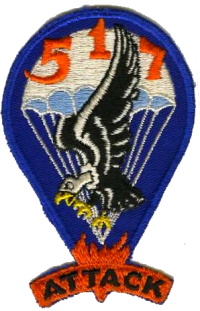 After Manhay, the 106-ID continued to hack away at the Bulge. The 517th Parachute Infantry Regiment was attached on January 11, and with the 424-IR, formed a tough battle-tried fighting team. The two regiments attacked on the northern side of the Bulge, jumping off along the Ambleve River between Stavelot and Trois-Ponts and along the Salm River to the south.
After Manhay, the 106-ID continued to hack away at the Bulge. The 517th Parachute Infantry Regiment was attached on January 11, and with the 424-IR, formed a tough battle-tried fighting team. The two regiments attacked on the northern side of the Bulge, jumping off along the Ambleve River between Stavelot and Trois-Ponts and along the Salm River to the south.
 Terrain was rugged-barren ridges, heavily wooded slopes, deep gullies. The enemy was well dug in and had been ordered to hold at all costs. But the men of the Lion Division had a score to settle. Determined, they smashed ahead. The attack on January 13 drove the enemy from positions east of Henumont, and the infantry advance carried to Mouhipré by late afternoon. In Henumont itself, resistance was rugged. The enemy made effective use of self propelled guns (Panzerfaust & Panzerschreck).
Terrain was rugged-barren ridges, heavily wooded slopes, deep gullies. The enemy was well dug in and had been ordered to hold at all costs. But the men of the Lion Division had a score to settle. Determined, they smashed ahead. The attack on January 13 drove the enemy from positions east of Henumont, and the infantry advance carried to Mouhipré by late afternoon. In Henumont itself, resistance was rugged. The enemy made effective use of self propelled guns (Panzerfaust & Panzerschreck).
During an assault on the strongly defended town, sudden crossfire from well-concealed machine guns halted Item Co 424-IR, scattered men and mortally wounded Lt Raymond S. Kautz (Raleigh, NC), the company commander, and the mortar platoon leader, Lt Robert A. Engstrom (Bayport, Minn). Although wounded himself, T/Sgt Harold R. Johnson (Flint, Mich), assumed command of the company. He was hit twice more while rallying the men, preparing to renew the attack. He personally directed intense accurate mortar and machine gun fire on the enemy automatic weapons, eventually led the men to their objective.
When his platoon of King Co 424-IR was pinned down by fire from an enemy emplaced machine gun, Pfc George S. Vasquez (St Paul, Minn) located the gun, went forward with his M-1 and wiped out the Nazi position single-handed. Charlie Co 424-IR, was held up by three enemy tanks. Lt Robert Honaker (Scarbro, WVa), led a bazooka team which destroyed one tank and repulsed the others. Lt Honaker later earned a battlefield commission and a Silver Star.

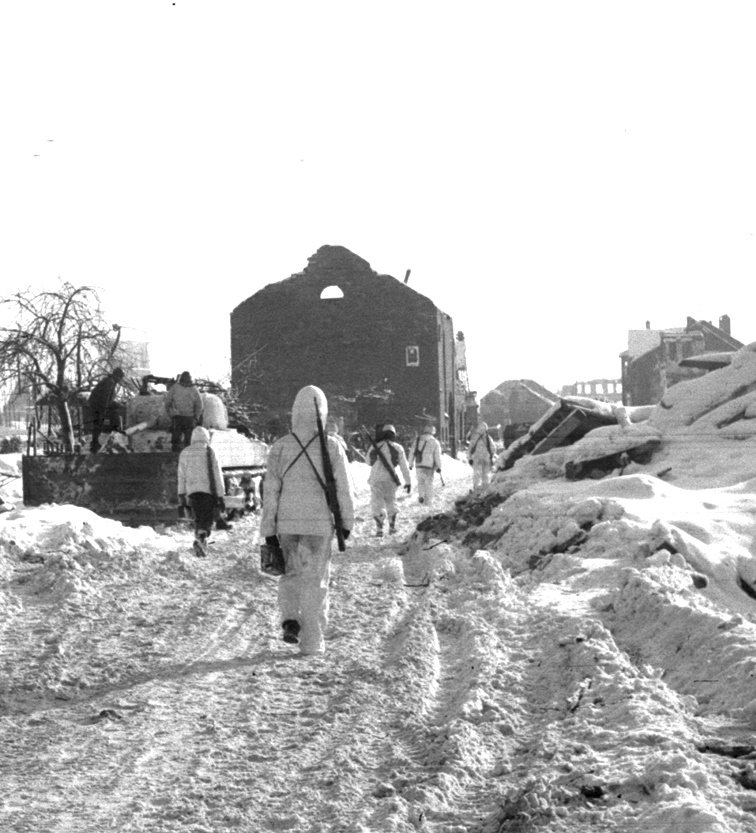 The 106-ID pressed south and east. The 1/424-IR, met serious opposition in front of La Coulée where the enemy was dug in on a strong and deep defensive line. Fighting was fierce, losses were heavy. While the 424-IR attacked to the front, engaging the main strength of the defenders, the 517-PIR swept around and cleared the town in a slam-bang action before the enemy could recover and regroup. After seizing all assigned objectives, the 106-ID was given the additional mission, on January 15, of taking the town of Ennal and the high ground to the east. Ennal was held by a strong force of Germans entrenched in the houses bristling with automatic weapons.
The 106-ID pressed south and east. The 1/424-IR, met serious opposition in front of La Coulée where the enemy was dug in on a strong and deep defensive line. Fighting was fierce, losses were heavy. While the 424-IR attacked to the front, engaging the main strength of the defenders, the 517-PIR swept around and cleared the town in a slam-bang action before the enemy could recover and regroup. After seizing all assigned objectives, the 106-ID was given the additional mission, on January 15, of taking the town of Ennal and the high ground to the east. Ennal was held by a strong force of Germans entrenched in the houses bristling with automatic weapons.

 Two platoons of King Co 424-IR punched their way into Ennal but were pinned down by devastating enemy fire. Ennal had to be secured by night. Available forces were organized and, as darkness approached, the town was taken by assault and cleared. Gen Perrin personally led the attack, for which he was awarded the DSC. On January 16, the 517-PIR which had reached the road from Petit-Thier to Poteau by nightfall was on the outskirts of Poteau. But the advance of the 30-ID and the 75-ID pinched off the 106-ID.
Two platoons of King Co 424-IR punched their way into Ennal but were pinned down by devastating enemy fire. Ennal had to be secured by night. Available forces were organized and, as darkness approached, the town was taken by assault and cleared. Gen Perrin personally led the attack, for which he was awarded the DSC. On January 16, the 517-PIR which had reached the road from Petit-Thier to Poteau by nightfall was on the outskirts of Poteau. But the advance of the 30-ID and the 75-ID pinched off the 106-ID.
The division was then ordered to mop up and by-passed enemy troops in the area. On January 22, Gen Perrin issued the following:
With the withdrawal of the 424-IR from the line on January 18, the major portion of the elements of this division completed a period of 34 days of practically continuous close combat with the enemy. Our artillery is still engaged. The events of that period are still fresh in your minds and in those of your men. The physical hardships endured, the constant exposure to rain, sleet and snow in freezing temperatures, and on terrain over which it was once considered impossible to wage effective warfare, have, so far as I know, rarely, if ever, been demanded of soldiers of any nation. Those twin enemies and weather and terrain have been our greatest problems, for certainly, wherever we have met the German, we have found that he is in no sense our equal.
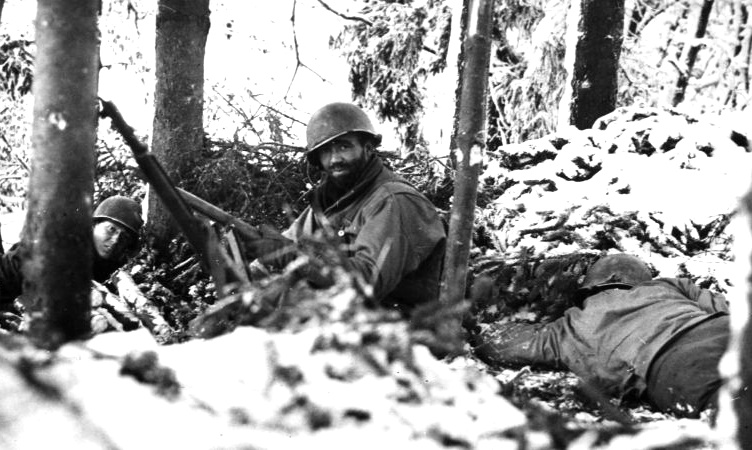 You and your men have met those demands and overcome them by a stubbornness of will, a fixed tenacity of purpose, and a grim and determined aggressiveness of body and spirit. You have accomplished your missions, and no bigher praise can ever be spoken of any military organization.
You and your men have met those demands and overcome them by a stubbornness of will, a fixed tenacity of purpose, and a grim and determined aggressiveness of body and spirit. You have accomplished your missions, and no bigher praise can ever be spoken of any military organization.
The 106-ID Has Record of Valor and Honor

 After a rest, the 424-RCT joined the 7-AD in the mission all Lion men had been waiting for: retaking St Vith. The 424-IR struck southeast on January 25 from a point just north of St Vith with the objective of securing the main highway running through Amel to the northeast. A coordinated infantry-tank attack dislodged a main enemy outpost at a road junction. By late afternoon, in the face of automatic weapons, 88-MM guns and small arms fire, doughs cleared the town of Medell. The following morning Meyerode fell to the furiously attacking 106-ID. The 7-AD then seized St Vith while the 106-ID took Deidenberg and Born. The 106-ID now was back at the line where it had first met the enemy.
After a rest, the 424-RCT joined the 7-AD in the mission all Lion men had been waiting for: retaking St Vith. The 424-IR struck southeast on January 25 from a point just north of St Vith with the objective of securing the main highway running through Amel to the northeast. A coordinated infantry-tank attack dislodged a main enemy outpost at a road junction. By late afternoon, in the face of automatic weapons, 88-MM guns and small arms fire, doughs cleared the town of Medell. The following morning Meyerode fell to the furiously attacking 106-ID. The 7-AD then seized St Vith while the 106-ID took Deidenberg and Born. The 106-ID now was back at the line where it had first met the enemy.
 It had taken fierce punishment but had come back in some of the bloodiest fighting of the war, a proud achievement for a division that had a history of less than two years. On February 28, 1945, Gen. Donald A. Stroh now was in command of the division. Lionmen, after a short rest, were back in the line on the south flank of 1-A near the Belgian town of Hunningen. For three weeks they had patrolled and probed the thickly-sown mine fields to find a weak spot in the pillboxes, concrete gun emplacements, dragon’s teeth and anti-tank obstacles of the Siegfried Line.
It had taken fierce punishment but had come back in some of the bloodiest fighting of the war, a proud achievement for a division that had a history of less than two years. On February 28, 1945, Gen. Donald A. Stroh now was in command of the division. Lionmen, after a short rest, were back in the line on the south flank of 1-A near the Belgian town of Hunningen. For three weeks they had patrolled and probed the thickly-sown mine fields to find a weak spot in the pillboxes, concrete gun emplacements, dragon’s teeth and anti-tank obstacles of the Siegfried Line.
Facing now the 106-ID was a division identified as one which had been in the attack on St Vith in December 1944. With the memory of the breakthrough still vivid, Lionmen sought vengeance. They got it. Charlie Co 424-IR, with combat engineers from Able Co 81-ECB, knocked out a large, particularly troublesome Nazi pillbox. The team clawed its way under machine gun and rifle fire, over four rows of anti-personnel mines and up to the very walls of the fort. Germans in their foxholes outside the pillbox were killed or driven off. Fire from the embrasures was silenced by flame throwers, rifle grenades and bazookas.

 Pvt Dennis A. Wartigun (Kearny, NJ), Able Co 81-ECB, approached the eight-foot thick walls and with a long pole, pushed a charge of TNT through an opening. The blast cracked the walls, blew open the door, killed three of the defenders. Doughs rushed in to capture nine other Germans who needed no further persuasion to surrender. Slowly, methodically, pillboxes fell.
Pvt Dennis A. Wartigun (Kearny, NJ), Able Co 81-ECB, approached the eight-foot thick walls and with a long pole, pushed a charge of TNT through an opening. The blast cracked the walls, blew open the door, killed three of the defenders. Doughs rushed in to capture nine other Germans who needed no further persuasion to surrender. Slowly, methodically, pillboxes fell.

 A week later, the 106-ID was well on its way through the bunkers and fortifications of the Siegfried Line heading toward the Rhine River. Fighting on the southern flank of V Corps and the 1-A, the 106-ID was in contact with 3-A to the south.
A week later, the 106-ID was well on its way through the bunkers and fortifications of the Siegfried Line heading toward the Rhine River. Fighting on the southern flank of V Corps and the 1-A, the 106-ID was in contact with 3-A to the south.
Led by 3/424-IR, Lionmen wrested Frauenkron from the enemy. Driving through fields of anti-tank and anti-personnel mines, the 424 crossed Lemert Creek, seized the towns of Berk, Kronenburg and Baasem, as it advanced toward its objective along the Simmer River. Other divisions of the V Corps started to swing to the southeast as the Siegfried Line was breached, pivoting on the 106-ID.
The 3-A continued to drive to the east, and the division was pinched out. After mopping-up operations, the division was pulled back to Corps reserve and the 517-PIR was relieved from the 106-ID control.
 Assigned to 15-A, the division moved to St Quentin, France, late in March. After a brief stay, it moved to Rennes, where reinforcements were brought in and the 422-IR and 423-IR, along with the 589-FAB and the 590-FAB, were reconstituted. For the first time since the division had gone into the line, it was up to full strength. A strenuous, tough training program was started for the reconstituted units at Rennes and later resumed at Coetquidan.
Assigned to 15-A, the division moved to St Quentin, France, late in March. After a brief stay, it moved to Rennes, where reinforcements were brought in and the 422-IR and 423-IR, along with the 589-FAB and the 590-FAB, were reconstituted. For the first time since the division had gone into the line, it was up to full strength. A strenuous, tough training program was started for the reconstituted units at Rennes and later resumed at Coetquidan.
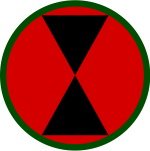
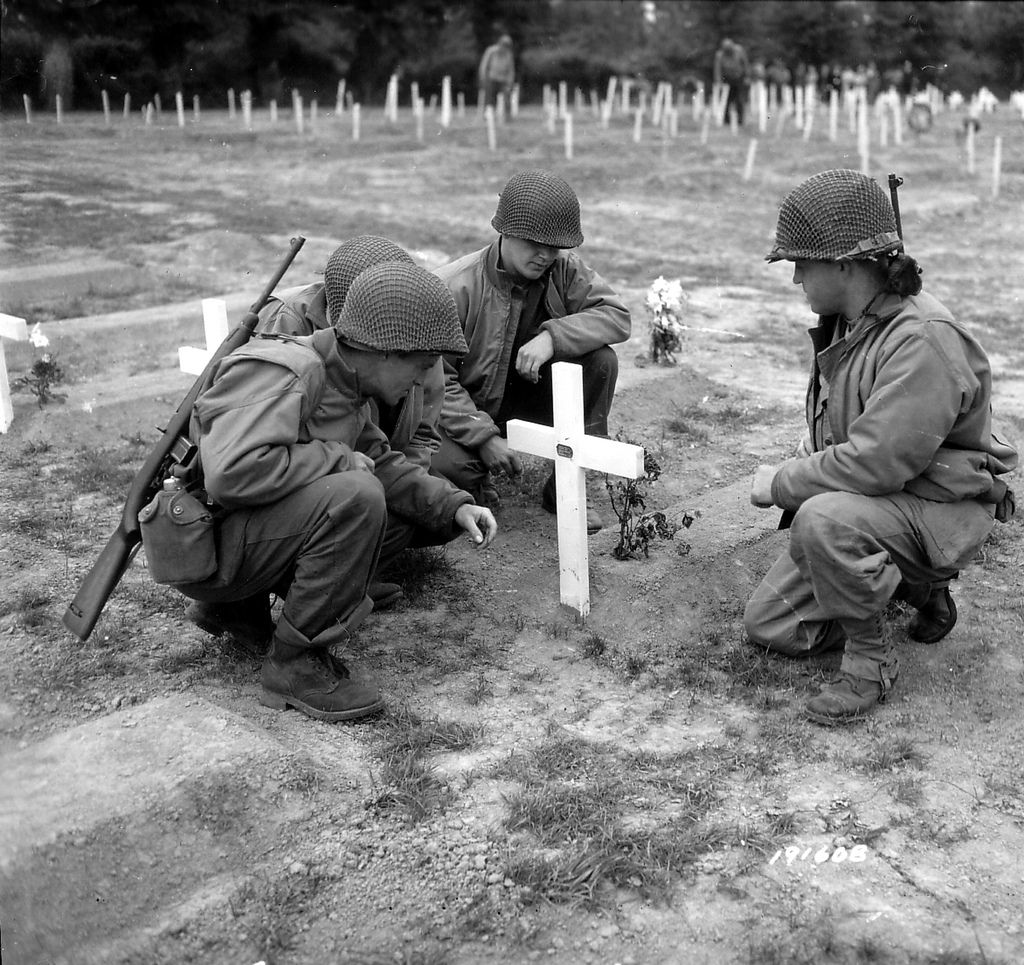 While at Rennes, 3/159-IR (7-ID), Aleutian veterans; and the 401-FAB and the 627-FAB were attached to the division. The 106-ID now was not only at full strength, it had a surplus — a far cry from the dark final days of December when the 424-IR and a few attached units were the division’s only force. An impressive ceremony was held on April 14, 1945, at the St Jacques airfield near Rennes. Survivors of the original 106 regiments lost in the breakthrough presented their colors to the new members of the 422 and 423-IRs.
While at Rennes, 3/159-IR (7-ID), Aleutian veterans; and the 401-FAB and the 627-FAB were attached to the division. The 106-ID now was not only at full strength, it had a surplus — a far cry from the dark final days of December when the 424-IR and a few attached units were the division’s only force. An impressive ceremony was held on April 14, 1945, at the St Jacques airfield near Rennes. Survivors of the original 106 regiments lost in the breakthrough presented their colors to the new members of the 422 and 423-IRs.
While the division stood at present arms on the parade ground, commanders, with the old and new color guards armed with German rifles captured in the Battle of the Bulge, advanced to the center of the field where they exchanged salutes. Colors and guidon were then presented to the new color guard. When the units reformed, the augmented division of five regiments and six artillery battalions passed in review before Gen Stroh. A similar ceremony on a smaller scale was held later in Germany by the 424-IR. During the hectic see-saw battle in the early days of the Ardennes breakthrough, the regiment lost its colors. After V-E Day, a medic of the 2-ID, then moving into Czechoslovakia, recovered the colors from a German prisoner and sent them back to the 106-ID. The colors were presented again to the 424th in an impressive ceremony.
While in the Rennes area, the 106th constituted the reserve for the 66-ID and French units containing the strong German garrisons on the coastal area of St Nazaire and Lorient. Plans were being made to relieve the 66-ID but orders came through for the division to return to Germany. Leaving the reconstituted units to complete their reorganization and training, the 424-IR, 3-IR and the 159-IR, with other units, raced across France to corral the thousands of prisoners being taken in the final drive through Germany. Spread out along both flanks of the Rhine from Holland to Switzerland, the 106-ID was reinforced to a strength of 40.000. Approximately, 1.500.000 PWs passed through 106-ID cages. It was a big job: receiving, screening, processing and discharging the hordes of former German soldiers. But it was a job the 106 relished; many of the Germans were the same ones whom they had battled in the Ardennes.
Meanwhile, the reconstituted units of the division moved from Coetquidan, to a training area near Mayen, Germany, named Camp Alan W. Jones for the former CG. They completed their training and were ready for action when Germany surrendered May 8, 1945. Following the surrender of Japan, the 106, now under the command of Gen Francis A. Woolfley, was alerted to return to the States. The division had been through some of the hardest fighting in the European Theater. It had suffered huge losses. It had no record of blitzkrieg offensives or mile-devouring advances. But it had more than that. The 106th had a story of valor and honor; of men who had stuck it out against the most powerful force the Germans could muster and had lashed back with the courage of lions. The men of the 106th could wear their insignia with pride.
Note: my copy of this original document was not complete, page 27 was missing.
Fortunately, I found this pages on the http://www.lonesentry.com website and this allowed me to publish the complete archive.














